Abstract
Electric vehicles (EVs) and photovoltaics (PVs) are expected to be broadly adopted in future power systems. However, the temporal variability of EV load and PV production presents challenges for integrating them into the power grid. This study evaluates and assesses the synergies between EVs and PV systems to maximize solar energy utilization for EV load coverage. The configurations studied include EV charging via the national grid as a reference case (Case 1) and two solar energy harvesting options: EVs powered directly by vehicle-mounted PVs (Case 2) and EV chargers connected to residential PV installations (Case 3). These cases are evaluated across different urban environments with large EV fleets and dissimilar weather conditions: Berlin and Los Angeles. A customized operation profile based on the worldwide harmonized light-duty test cycle (WLTC) and a charge-right-away (CRA) strategy is used. Energy performance analysis is conducted through dynamic simulations using the Modelica language, with environmental and economic indices derived. Key findings highlight the superior performance of residential PV systems in both cities compared to current solar EV technologies, with both solutions offering significant benefits over the reference case. Cases 2 and 3 result in a 44% and 59% reduction in annual energy consumption, greenhouse gas emissions, and charging costs in Berlin, while in Los Angeles, the reductions are 67% and 98%. The average daily solar driving range reaches 20.3% in Berlin and 30.4% in Los Angeles.
1. Introduction
Annual direct global greenhouse gas (GHG) emissions from transportation, measured in metric tons of carbon dioxide equivalent, are estimated to represent about 15% of total emissions across all sectors. Two-thirds of total transportation GHG emissions are associated with road vehicles [1,2,3]. This vehicle category mainly includes light-, medium- and heavy-duty trucks and passenger cars. Thus, the electrification of vehicles is continuously developing to minimize their effect on the climate crisis.
In 2022, the global EV fleet’s total electricity consumption was approximately 110 TWh, equivalent to the Netherlands’ total electricity demand [4]. Recent projections by the International Energy Agency (IEA) estimate that electricity demand for EVs will range between 950 and 1150 TWh by 2030. The first scenario is based on the stated policies and the second on the announced pledges. Under these scenarios, EV electricity demand is expected to represent 3.2% to 3.8% of final global electricity consumption. This translates to GHG emissions resulting from the electricity generation mix and the accelerated aging of distribution transformers due to overloading. Hence, the concept of self-consumption in road vehicles could play a critical role in the energy transition within the transport sector. Solar energy is the most convenient energy source for this role considering technical feasibility. The subject of this study is the examination and evaluation of different options for EVs’ power supply using PV technology.
Over the last few years, several studies have been conducted on the synergy between PV and EV systems. Many studies focus on the powertrain topology. The hybrid solar vehicle (HSV) concept, discussed in [5], offers a solution for reducing emissions compared to hybrid electric vehicles (HEVs), which heavily rely on the electricity grid’s energy mix. It is also noted that simulations are valuable for assessing the economic impact of installing PV panels on vehicles. In [6], an extensive review of possible configurations and standards of the connection between EVs and PV systems and related power converters is conducted. In 2017, Coffman et al. [7] substantiated that Hawaii was not yet mature enough to adopt commercially available EVs at the time as a GHG-abatement strategy based on the life-cycle cost and greenhouse gas emissions associated with market prices and the status of the electricity generation mix of this year. However, they demonstrated that this issue could be resolved just by utilizing the solar energy retrieved during weekends for EV charging. They also suggested that policy measures are necessary to match EV charging with spatially and temporally varying RES.
Growing interest in the topic has expanded research into additional areas. Jiang et al. developed a solar-oriented route planning algorithm to balance energy harvesting and consumption in urban areas where available solar irradiance is unpredictable due to variable shading within the city [8]. In [9], three scenarios representing different methods of absorbing solar power for charging the electric buses of a university campus are compared. In [10], PV-powered EV charging systems (EVCSs) are reviewed comprehensively, involving all possible modes of operation of a solar charging station, solar rooftops, vehicle-integrated PV (ViPV) systems, and solar parking lots. Mouli et al. studied a 10 kW solar-powered bidirectional EV charger compatible with two charging standards, namely, “Charge de Move” (CHAdeMO) and combined charging standard (CCS) [11]. Focus is given to the power converters and an experimental prototype is developed and tested with a V2G-enabled Nissan Leaf and a CHAdeMO controller. Peak efficiency ranges between 95.2% and 96.4%, with power density three times higher than existing solutions at the time. Reference [12] reviews the economic, environmental, and social benefits of solar-powered EV-charging networks, and suggests implementing a demand management price (DMP) rate beneficial to both utility services and EV drivers. Ding et al. [13] proposed a reconfigurable PV array structure for an EV onboard system. Experimental testing of the proposed algorithms, through measurements of solar irradiance at five points on the vehicle, showed a 149% increase in system efficiency. Other research has studied optimal configurations and approaches for effectively charging EV batteries with energy recovered by PV panels [14,15]. Several applications of exploiting solar energy for vehicle charging have also been recently studied in the aviation [16] and shipping [17] sectors.
A few studies have focused on developing models of PV-powered EV powertrains, incorporating detailed physics modeling of the energy exchange between interacting components under varying external conditions. In [18], a case study on utilizing PV panels to extend the range of EVs in Ukraine shows that 1.16% and 6.32% of the range of the New European Driving Cycle (NEDC) could be covered by solar energy during the winter and summer months, respectively. However, energy savings calculations are based on the available solar irradiance and the constant specific energy consumption per kilometer, as provided by the US Environmental Protection Agency (EPA) and NEDC, while the energy transfer between EV powertrain subsystems is neglected. Nivas et al. [19] presented a simulation model of the energy processes of an EV charged by PV panels using MATLAB Simscape. Models of EV powertrain components are involved, including the PV array, the MPPT algorithm block, the power converters, the battery, and the motor. Although results show that AC and DC power, voltage, and current can be tracked at all system points, the data used indicate that these results do not correspond to any realistic solar EV application. In [20], an onboard PV system for a plug-in EV is modeled, and the energy and economic impacts are evaluated among different weather conditions for five commercial vehicles that represent a range of design specifications. Results show that the daily driving range could be extended from 4.8 km to 100.6 km. Mobarak et al. [21] conducted a detailed study on a solar-powered EV. Their research involved integrating a thin-film solar cell panel into an EV, considering the effects of panel tilt, vehicle direction, and partial shading on solar generation in urban environments. A solar EV (SEV) model was developed in MATLAB/Simulink. However, a simple single resistor circuit was used to model the EV battery neglecting its transient response. Simulations for Los Angeles and Detroit revealed that annual energy consumption was reduced by 21.5% and 17.5%, respectively. The daily solar range extension peaks at 47 km/day in Detroit.
This work aims to study and evaluate the use of solar energy for recharging EVs. Three cases are considered: a reference case of an EV charging directly by the national grid, a second case where EV can recharge by solar energy through mounted PVs, and a third case where solar power is supplied to the EV charger through residential PV panels. The analysis is conducted in Berlin and Los Angeles, cities with different weather conditions that are expected to significantly impact system performance. Moreover, these cities are selected because of the large share of EVs in their total vehicle fleet. Compared to the relevant literature, a dynamic SEV system model with an adequately accurate representation of each powertrain subsystem is developed. A customized driving cycle based on the worldwide harmonized light-duty test cycle (WLTC) is employed to simulate realistic EV operation. Dynamic modeling improves the accuracy of estimating EV energy consumption and state of charge (SoC). The energy consumption results are used to derive economic and environmental metrics and further evaluate the examined cases in both locations.
In summary, the key contributions of this work compared to previous studies are as follows:
- Dynamic modeling of SEVs using accurate subsystem models and the advantages of the Modelica language;
- Evaluation of system performance with a realistic customized driving cycle;
- Analysis of system operation in Berlin and Los Angeles, two cities with high EV market share and different variation in solar irradiance and ambient temperature throughout the year;
- Use of selected metrics to assess the examined solutions’ energy, environmental, and economic performance.
2. Methodology
This section presents a methodology framework developed to evaluate and compare the available options for using solar energy to recharge light-duty EV batteries. Figure 1 provides an overview of the methodology followed.
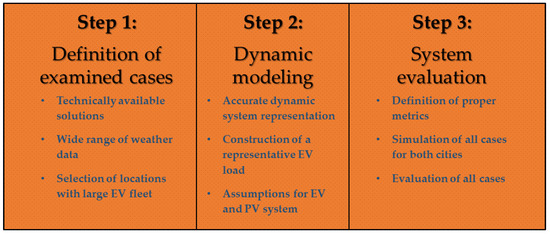
Figure 1.
Overview of the methodology.
2.1. Examined Cases
This study categorizes the examined solutions into three cases. The first case, serving as a reference, involves an EV charged via a residential charger connected to the national grid of the location under study, considering the actual values for RES share and electricity prices. The second case examines an SEV with mounted PVs using chargers connected to the national grid. The third case features charging by a residential EV charger, which can also be powered by a stationary battery system storing energy from rooftop PVs. Table 1 lists all cases.

Table 1.
A list of cases with the examined EV–PV synergies.
2.2. Climate Conditions
A comparative analysis examines different weather conditions to assess the EV–PV synergy options. The analysis covers weather conditions with consistently high solar irradiance and those with lower irradiance and greater monthly variability. Table 2 lists two cities chosen to represent a broad range of weather conditions. Los Angeles, with a hot semi-arid climate (BSh according to the Köppen classification), and Berlin, with an oceanic climate (Cfb), are the selected cities. Berlin receives 1068.6 kWh/m2 of global horizontal irradiation (GHI) annually, while Los Angeles receives 1966.1 kWh/m2. Direct normal irradiation (DNI) is 973.5 kWh/m2 in Berlin and 2138.4 kWh/m2 in Los Angeles. These cities were also chosen because California and Germany have some of the highest EV market penetrations, at 3.85% and 5.4% of cars, respectively. Additionally, Germany had the largest stock of plug-in EVs in Europe as of January 2022, and California was the largest regional market for plug-in EVs in the United States as of November 2021. Simulations for both cities were conducted for both solar and non-solar EVs to estimate energy consumption before deriving economic and environmental indicators.

Table 2.
Cities used for comparing the examined cases under different weather conditions.
2.3. Modeling Approach
Models were developed using the equation-based Modelica language for dynamic representation of multi-domain physical systems, with simulations performed using the Dymola integrated development environment (IDE) [22]. Section 3 provides a comprehensive description of the models. The system models were built upon models previously presented by the authors and other components made available from open-source libraries.
Dynamic modeling of all interacting components allows for analyzing the impact of external conditions, such as weather and driving schedules, on system performance. A detailed representation of the system’s main energy and control subsystems enables the accurate estimation of undergoing energy transactions. These include the considered PV and EV systems, weather conditions, driving schedules, and charging logic control. This strengthens the methodology followed to increase the accuracy of estimating energy consumption. Moreover, the extension property of the Modelica language enables a convenient simulation of multiple scenarios.
2.4. EV Operation
To draw meaningful comparisons, a common load for the EV powertrain is introduced and applied to a single vehicle of the total fleet. A customized driving cycle has been designed for this purpose. Table 3 presents the customized driving cycle used in this study. The driving cycle is set to 24 h, with the worldwide harmonized light-duty test cycle (WLTC) Class 3 [23] repeated throughout the day to create a representative daily driving schedule. The average daily driving distance is subject to significant uncertainty and varies by location and specific transport characteristics. Other studies provide reference values ranging from 25 km/day to 65 km/day [24,25], while the WLTC driving distance is 23.266 km. Therefore, for the specific application, two repetitions of WLTC are considered for a single weekday. The first repetition corresponds to a morning departure at 7 a.m. and the second to an afternoon return at 5 p.m. Each month, data for the average solar irradiance and air temperature are extracted and used as the necessary profile for a daily simulation. Daily energy consumption is calculated for each weekday and adjusted by a reduction factor of 0.5 to estimate weekend consumption. The total monthly consumption is determined by adding the daily consumptions for each day of the month.

Table 3.
Customized driving cycle based on two repetitions of WLTC.
Moreover, the assumed HVAC load of the EV varies with outdoor temperature to reflect seasonal and locational differences, as presented in [21]. Maximum heating power is set to 4 kW and cooling power to 2 kW, with a linear interpolation of the load based on the ambient temperature. A constant load of 300 W is considered for auxiliary loads during vehicle motion. For SEVs, the mounted PV is assumed to have an optimal south-facing orientation and a flat surface with a zero-degree tilt, ignoring shading effects.
2.5. Evaluation Metrics
Metrics have been selected to benchmark the examined cases. Table 4 lists these metrics.

Table 4.
Metrics used for evaluating system operation.
Solar range extension is calculated using Equation (1):
where is the daily energy produced by the mounted PV panels and is the energy consumption of the non-solar EV per 100 km.
3. Modeling
3.1. PV System
Accurate representation of all components is essential for the PV configuration. These components include the PV module with individual cells, the power converter between PV and battery systems, and a block implementing the maximum power point tracking (MPPT) algorithm. The Photovoltaics open-source Modelica library, which offers detailed and accurate component models, is used to model all interacting parts [26].
The PV cell model, as introduced by [27], consists of a diode and current source. This model allows PV modeling using the module datasheet parameters referring to standard conditions (STC). A DC–DC converter model is designed considering the following characteristics:
- Conduction and switching losses are neglected.
- Ideal power conversion is assumed.
- The voltage of the photovoltaic DC side can be controlled via a signal input.
- An integrated maximum power point tracker (MPPT) algorithm maximizes harvested energy.
3.2. EV System
The system model presented in [28] is used to study the energy performance of the EV. This model focuses on simulating the dynamic operation of an EV at a system level, incorporating all powertrain and control subsystems. It consists of subsystems for the driver, powertrain control module, electric plant, and drivetrain. An equivalent circuit model (ECM) is used to represent each battery cell and the Coulomb counting technique is applied to estimate SoC. The velocity profile is used as input, and the operation of the EV powertrain is controlled to supply the required power to the vehicle drivetrain. The main parts of the EV system that are considered include:
- Driver control actions to follow the driving cycle;
- The battery control system;
- Energy recuperation through regenerative braking;
- The EV powertrain, including the battery pack, motor, drive, and mechanical drivetrain.
3.3. Weather Conditions
Weather conditions are important for an accurate evaluation of the entire system operation. Data from the Photovoltaic Geographical Information System (PVGIS), a service provided by the European Commission [29], have been used for the locations under study.
3.4. System Model
3.4.1. EV Charging from Both Charger and Mounted PV
To describe all the ongoing energy transactions, a system model has been created for the case of a PV-mounted EV (Case 2). The model is presented in Figure 2.
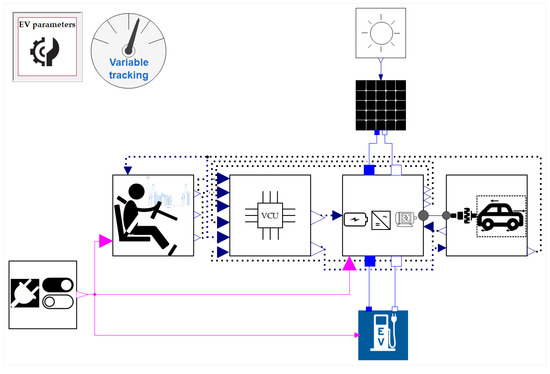
Figure 2.
Overview of the developed solar EV model within the Dymola user interface.
Among the main EV subsystem blocks, the driver control ensures the requested driving cycle is met, based on the vehicle velocity and SoC levels. The vehicle control unit (VCU) monitors all system variables and transfers the signal of the requested torque to the EV powertrain and the brake command to the mechanical drivetrain. Inside the powertrain, the battery, power converter, and motor components are interconnected as electrical components. Signals of battery SoC and voltage and current quantities of all components are sent to the control unit. The mechanical part of the motor is coupled with the vehicle drivetrain. A rotational speed signal is sent to the control unit to ensure operation within vehicle specifications.
Compared to the EV model in [28], a constant current–constant voltage (CCCV) charger and the mounted PV equipment have been integrated into the configuration. The charger ensures charging takes place until the maximum allowed SoC is reached. On top of that, a charging control block has been designed. This block considers two factors: the level of the remaining SoC and whether the vehicle is in motion or parked and thus available for charging. The selected charging strategy is known as charge right away (CRA), meaning that charging starts after the last trip of the day. The PV equipment includes the PV module, a block that implements the MPPT algorithm, and a DC–DC power converter, as already described in Section 3.1.
3.4.2. EV Charging Only from the Charger
Without any PVs mounted on the EV, the EV battery can be connected directly only to the charger. This model represents all cases where power to the EV is supplied solely through a charger (Cases 1 and 3). Specifically for Case 3, it is assumed that an independent PV system is installed and connected to a stationary battery energy storage system (BESS). The operation of this BESS is not simulated, as it is considered to be able to store and supply the full contribution of the PV system. The energy produced by the PV system is subtracted from the amount of energy supplied by the grid.
4. Simulation and Results
4.1. Model Input Data
Before model simulation, system specification data must be imported. The specifications of the commercially available long-range solar car Lightyear 0 were used for both EV cases: with and without mounted PVs. Information for the Tesla Model 3 from [30] has been used for data unavailable from the manufacturer. All data used for the simulations are presented in Table 5.

Table 5.
Parameters used for model simulations.
For Case 3, which examines a rooftop PV system for harvesting solar energy to recharge the EV battery, a 2 kWp system with optimized slope and azimuth angles is simulated.
For the environmental assessment, the GHG intensity of electricity is obtained as 220 kg CO2-eq/MWh for Los Angeles [31] and 440 kg CO2-eq/MWh for Berlin [32], based on 2021 data. The latest published electricity prices are also retrieved for both cities, with values of USD 0.3431 for Los Angeles [33], and USD 0.2707 for Berlin [34]. The uncertainty typically associated with the charging tariff is not considered, and these fixed values are used.
4.2. Results
This section presents the study results. Figure 3a shows the vehicle velocity based on the applied profile. As already discussed in Section 2.4, it includes two repetitions of the WLTC driving cycle. Figure 3b illustrates the comparison of the EV’s SoC daily evolution under various conditions. Coulomb counting is used to estimate the evolution of SoC, as described in Section 3.2. The comparison includes results from January and July for each city, which vary significantly in solar irradiance and ambient temperature. Both solar and non-solar EVs are examined. For non-solar EVs, the deviation between curves is relatively low. In contrast, the SoC evolution of SEVs presents a notable difference between the examined conditions. While SoC increases similarly in July for Berlin and Los Angeles, there is a significant deviation in January. In Los Angeles, SoC surpasses 92% during daylight, whereas in Berlin, it only rises from 83.9% to just 86.1% due to lower solar irradiance.
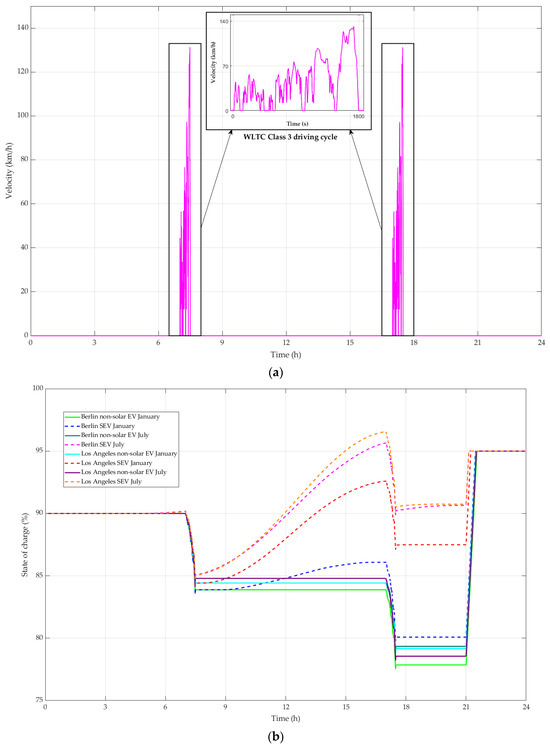
Figure 3.
Vehicle performance. (a) Velocity profile of the applied driving cycle. (b) State of charge under multiple operating conditions for solar and non-solar EVs in Berlin and Los Angeles.
So far, the comparison has been between solar and non-solar EVs. For the remaining metrics defined in Section 2.5, energy recovered by residential PVs in Case 3 is considered self-consumption and subtracted from the grid energy needed for both cities.
Figure 4 shows the monthly average energy consumption per 100 km for the three cases under study. In Case 1, the difference in consumption presents a slight difference which is mainly associated with weather conditions. From November until March, consumption is slightly lower in Los Angeles where higher solar irradiance is available and higher temperature values lead to lower heating load. During the rest months, the consumption is a few larger in Los Angeles due to the higher levels of temperature and therefore increased cooling load. Consumption per 100 km ranges from 23 kWh/100 km to 25.5 kWh/100 km in both cities. In Case 2, the lower deviation of Los Angeles solar irradiance throughout the year enables a high reduction of consumption for all months. An average monthly consumption of 7.9 kWh/100 km is achieved. On the contrary, in Berlin, during months with low available solar irradiance (from November until February) energy to recharge the EV battery mainly comes from the grid. Energy consumption ranges between 6.5 kWh/100 km in July and 22.4 kWh/100 km in December, with an average monthly value of 13.4 kWh/100 km. In Case 3, the PV installation fully covers the EV load in Los Angeles from February to November, resulting in zero consumption. The average monthly consumption is just 0.5 kWh/100 km. In Berlin, solar yield is mainly used during months with high irradiance, significantly reducing grid energy consumption during these periods. Minimum consumption reaches 2 kWh/100 km in June while the maximum value is 20.4 kWh/100 km in December. The average monthly consumption equals 9.8 kWh/100 km. Overall, the results are better for both cities compared to Case 2.
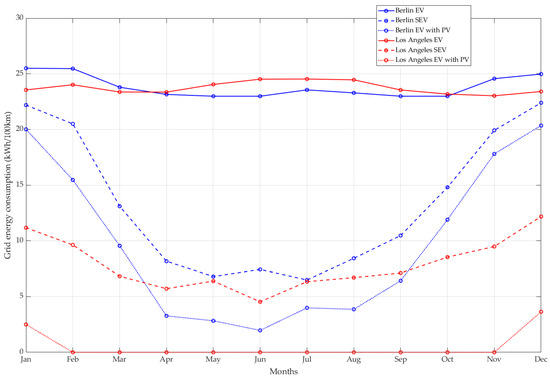
Figure 4.
Monthly average energy consumption per 100 km for the 3 examined cases in Berlin and Los Angeles.
Figure 5 compares the daily solar range extension provided by the SEV relative to a non-solar EV in both cities. This metric does not apply to Case 3, as the requirement to park and charge the EV remains unchanged, making its range equivalent to Case 1. The results indicate that Los Angeles benefits from superior weather conditions for utilizing solar energy captured by PV panels. In Los Angeles, the daily solar range extension ranges from 22 to 37 km/day. In contrast, in Berlin, the range extension varies from just under 5 km/day in December to 33 km/day in July.
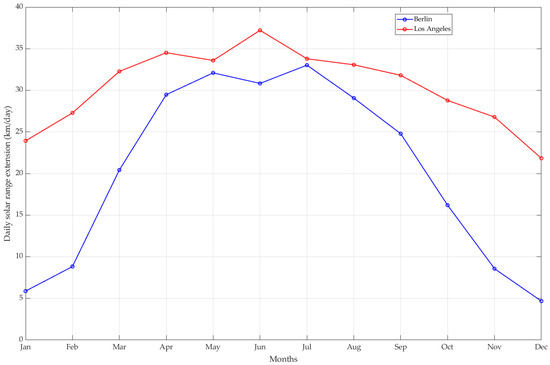
Figure 5.
Daily solar range extension for a solar and a non-solar EV in Berlin and Los Angeles.
Figure 6 illustrates the monthly GHG emissions. In Berlin, utilizing an SEV significantly reduces GHG emissions, with even greater reductions when PV panels are used. This trend is also observed in Los Angeles, where emissions are generally lower than in Berlin throughout most months. Notably, in Case 3, emissions in Los Angeles are zero for ten months (February through November).
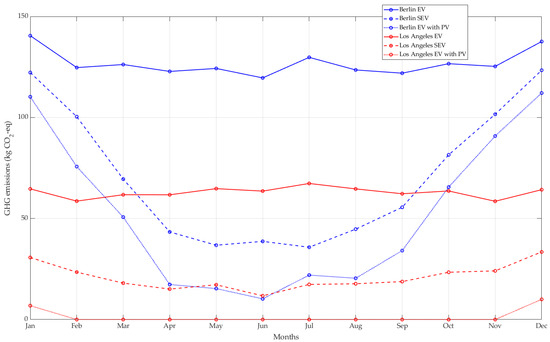
Figure 6.
Monthly GHG emissions for the 3 examined cases in Berlin and Los Angeles.
Figure 7 presents the monthly charging costs for all examined cases. Interestingly, while the charging cost for an EV in Los Angeles is significantly higher than in Berlin, using an SEV inverts this scenario, providing greater savings for users. Specifically, Case 3 is the most cost-effective for both cities, with zero charging costs for most months (February through November).
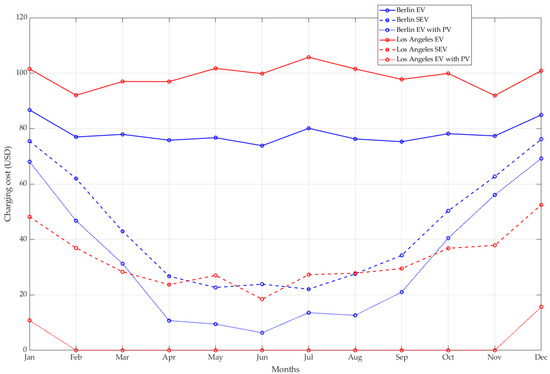
Figure 7.
Monthly charging cost for the 3 examined cases in Berlin and Los Angeles.
The next figures provide an insight into the comparison among the three cases at an annual level. Figure 8 reveals that in Case 1, the average grid energy consumption per 100 km is 23.9 kWh/100 km in Berlin and 23.8 kWh/100 km in Los Angeles. In Case 2, these values are reduced by 44% in Berlin and 59% in Los Angeles. Case 3 shows the most significant reduction in grid energy consumption, although the extent varies between cities. In Berlin, the reduction is similar to that of Case 2, while in Los Angeles, it is significantly better, resulting in a grid energy consumption of just 0.5 kWh/100 km, equivalent to 4189 MPGe.

Figure 8.
Average annual grid energy consumption per 100 km for the 3 examined cases in Berlin and Los Angeles.
Figure 9 and Figure 10 present the annual GHG emissions and the annual charging costs, respectively. As anticipated, the reduction percentages align with the reductions observed in annual energy consumption. Notably, the use of an SEV in Berlin results in higher GHG emissions compared to an EV in Los Angeles (853.3 kg CO2-eq vs. 755.6 kg CO2-eq). This highlights a critical insight: improvements in EV energy efficiency alone cannot always compensate for the need for a low-GHG electricity mix. Conversely, regarding annual charging costs, cities like Los Angeles with higher electricity prices but similar weather conditions can benefit significantly from SEVs or PV-powered EV chargers. A 2 kWp PV system results in an annual charging cost of USD 26.5, while the same PV installation in Berlin leads to a charging cost of USD 385.5, which is comparable to the SEV charging cost in Los Angeles (USD 394.3).
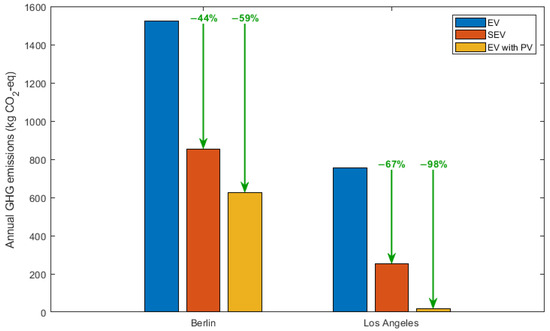
Figure 9.
Annual GHG emissions for the 3 examined cases in Berlin and Los Angeles.
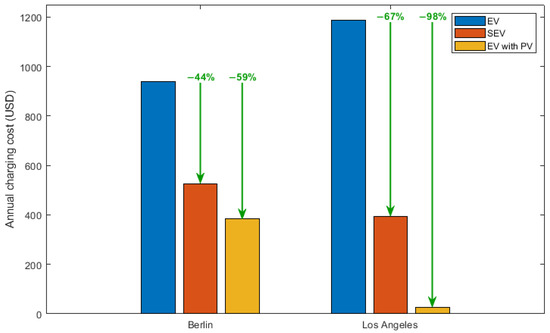
Figure 10.
Annual charging cost for the 3 examined cases in Berlin and Los Angeles.
Table 6 summarizes the key results of this comparative analysis.

Table 6.
Consolidation of the key results.
5. Conclusions
This study presents a comparative analysis and evaluation of technologically mature alternatives for recharging EVs using solar energy harnessed by PV systems. Three cases are examined. Case 1, where an EV is charged via a residential grid-connected charger; Case 2, which involves a solar EV (SEV) with mounted PVs; and Case 3, which utilizes a residential PV-battery installation to supply power to the charger. These scenarios are assessed in two cities with differing climates but high EV adoption rates: Berlin and Los Angeles.
The results indicate significant benefits for both cities when adopting Case 2 and Case 3 solutions. In Case 1, the annual grid energy consumption per 100 km is 23.9 kWh/100 km in Berlin and 23.8 kWh/100 km in Los Angeles. This value is reduced by 44% in Berlin and by 67% in Los Angeles for Case 2. In Case 3, the reduction is even more pronounced, with a 59% decrease in Berlin and a 98% decrease in Los Angeles. However, the reduction is limited in Berlin from November until February.
The use of an SEV also appears to reduce drivers’ range anxiety by providing on average an additional driving range of 20.3 km/day in Berlin and 30.4 km/day in Los Angeles. Environmental benefits are notable as well. In Case 1, the annual GHG emissions are 1522.9 kg CO2-eq in Berlin and 755.6 kg CO2-eq in Los Angeles. Case 2 reduces these emissions to 853.3 kg CO2-eq in Berlin and 624.5 kg CO2-eq in Los Angeles. With Case 3, the emissions are further reduced to a minimum of 624.5 kg CO2-eq in Berlin and 16.9 kg CO2-eq in Los Angeles.
Annual charging cost presents a higher reduction for Los Angeles, since the reference cost of USD 1186.8 for Case 1 is decreased to USD 394.3 for Case 2 and only USD 26.5 for Case 3. In Berlin, the charging cost of Case 1 equals USD 940, and lower costs of USD 526.7 and 385.5 USD are accomplished in Cases 2 and 3, respectively. While the initial charging cost in Berlin is lower than in Los Angeles, Cases 2 and 3 still incur higher costs in Berlin due to the lower availability of solar irradiance.
In all examined cases, the quantitative results of this study strongly depend on the use of the selected driving cycle. To overcome this limitation, future work could estimate the benefits or drawbacks of the examined cases for multiple EVs classified by their duty, distance, and behavior. Moreover, the study of SEVs with higher efficiency based on the specifications given for prototypes under development could accelerate their market entry. To assess the financial benefits of the examined cases, a long-term investment evaluation would be useful.
Author Contributions
Conceptualization, R.R., P.I., N.N. and A.T.; methodology, R.R.; software, R.R.; investigation, R.R.; writing—original draft preparation, R.R., P.I., N.N. and A.T.; writing—review and editing, R.R., P.I., N.N. and A.T.; visualization, R.R.; supervision, N.N. and A.T. All authors have read and agreed to the published version of the manuscript.
Funding
This research has been carried out in the framework of the European Union’s Horizon Europe Research and Innovation program under grant agreement 101056874 (SCALE—Smart Charging Alignment for Europe).
Data Availability Statement
The raw data supporting the conclusions of this article will be made available by the authors on request.
Conflicts of Interest
The authors declare no conflicts of interest.
References
- Breakdown of Carbon Dioxide, Methane and Nitrous Oxide Emissions by Sector. Available online: https://ourworldindata.org/emissions-by-sector (accessed on 30 July 2024).
- Climate Change 2022—Mitigation of Climate Change: Working Group III Contribution to the Sixth Assessment Report of the Intergovernmental Panel on Climate Change, 1st ed.; Intergovernmental Panel On Climate Change (IPCC), Ed.; Cambridge University Press: Cambridge, UK; New York, NY, USA, 2023; ISBN 978-1-00-915792-6. [Google Scholar]
- Greenhouse Gas Emissions from Transport in Europe. Available online: https://www.eea.europa.eu/en/analysis/indicators/greenhouse-gas-emissions-from-transport (accessed on 30 July 2024).
- International Energy Agency. Global EV Outlook 2023: Catching Up with Climate Ambitions; Global EV Outlook; OECD: Paris, France, 2023; ISBN 978-92-64-85692-9. [Google Scholar]
- Conti, S.; Di Mauro, S.; Raciti, A.; Rizzo, S.A.; Susinni, G.; Musumeci, S.; Tenconi, A. Solar Electric Vehicles: State-of-the-Art and Perspectives. In Proceedings of the 2018 AEIT International Annual Conference, Bari, Italy, 3–5 October 2018; pp. 1–6. [Google Scholar]
- Nasr Esfahani, F.; Darwish, A.; Williams, B.W. Power Converter Topologies for Grid-Tied Solar Photovoltaic (PV) Powered Electric Vehicles (EVs)—A Comprehensive Review. Energies 2022, 15, 4648. [Google Scholar] [CrossRef]
- Coffman, M.; Bernstein, P.; Wee, S. Integrating Electric Vehicles and Residential Solar PV. Transp. Policy 2017, 53, 30–38. [Google Scholar] [CrossRef]
- Jiang, L.; Hua, Y.; Ma, C.; Liu, X. SunChase: Energy-Efficient Route Planning for Solar-Powered EVs. In Proceedings of the 2017 IEEE 37th International Conference on Distributed Computing Systems (ICDCS), Atlanta, GA, USA, 5–8 June 2017; pp. 383–393. [Google Scholar]
- Ioannidis, R.; Iliopoulou, T.; Iliopoulou, C.; Katikas, L.; Petsou, A.; Merakou, M.-E.; Asimomiti, M.-E.; Pelekanos, N.; Koudouris, G.; Dimitriadis, P.; et al. Solar-Powered Bus Route: Introducing Renewable Energy into a University Campus Transport System. Adv. Geosci. 2019, 49, 215–224. [Google Scholar] [CrossRef][Green Version]
- Khan, S.; Ahmad, A.; Ahmad, F.; Shafaati Shemami, M.; Saad Alam, M.; Khateeb, S. A Comprehensive Review on Solar Powered Electric Vehicle Charging System. Smart Sci. 2018, 6, 54–79. [Google Scholar] [CrossRef]
- Chandra Mouli, G.R.; Schijffelen, J.; Van Den Heuvel, M.; Kardolus, M.; Bauer, P. A 10 kW Solar-Powered Bidirectional EV Charger Compatible with Chademo and COMBO. IEEE Trans. Power Electron. 2019, 34, 1082–1098. [Google Scholar] [CrossRef]
- Erickson, L.; Ma, S. Solar-Powered Charging Networks for Electric Vehicles. Energies 2021, 14, 966. [Google Scholar] [CrossRef]
- Ding, C.; Li, H.; Zheng, W.; Wang, Y.; Lin, X. Reconfigurable Photovoltaic Systems for Electric Vehicles. IEEE Des. Test 2018, 35, 37–43. [Google Scholar] [CrossRef]
- Duan, C.; Wang, C.; Li, Z.; Chen, J.; Wang, S.; Snyder, A.; Jiang, C. A Solar Power-Assisted Battery Balancing System for Electric Vehicles. IEEE Trans. Transp. Electrif. 2018, 4, 432–443. [Google Scholar] [CrossRef]
- Grosso, M.; Lena, D.; Bocca, A.; Macii, A.; Rinaudo, S. Energy-Efficient Battery Charging in Electric Vehicles with Solar Panels. In Proceedings of the 2016 IEEE 2nd International Forum on Research and Technologies for Society and Industry Leveraging a better tomorrow (RTSI), Bologna, Italy, 7–9 September 2016; pp. 1–5. [Google Scholar]
- Shukla, A.; Nema, S. Design of Electrical System of Solar Powered Airplane. In Proceedings of the 2023 IEEE Renewable Energy and Sustainable E-Mobility Conference (RESEM), Bhopal, India, 17–18 May 2023; pp. 1–6. [Google Scholar]
- Zhang, R.; Liang, H. Application of Solar Energy in Ship Power Field. In Proceedings of the 2022 IEEE Asia-Pacific Conference on Image Processing, Electronics and Computers (IPEC), Dalian, China, 14–16 April 2022; pp. 1588–1590. [Google Scholar]
- Diahovchenko, I.; Petrichenko, L.; Borzenkov, I.; Kolcun, M. Application of Photovoltaic Panels in Electric Vehicles to Enhance the Range. Heliyon 2022, 8, e12425. [Google Scholar] [CrossRef] [PubMed]
- Nivas, M.; Rao Naidu, R.K.P.; Mishra, D.P.; Salkuti, S.R. Modeling and Analysis of Solar-Powered Electric Vehicles. Int. J. Power Electron. Drive Syst. 2022, 13, 480. [Google Scholar] [CrossRef]
- Abdelhamid, M.; Pilla, S.; Singh, R.; Haque, I.; Filipi, Z. A Comprehensive Optimized Model for On-Board Solar Photovoltaic System for Plug-in Electric Vehicles: Energy and Economic Impacts: On-Board Solar Photovoltaic System for Plug-in Electric Vehicles. Int. J. Energy Res. 2016, 40, 1489–1508. [Google Scholar] [CrossRef]
- Mobarak, M.H.; Kleiman, R.N.; Bauman, J. Solar-Charged Electric Vehicles: A Comprehensive Analysis of Grid, Driver, and Environmental Benefits. IEEE Trans. Transp. Electrif. 2021, 7, 579–603. [Google Scholar] [CrossRef]
- Dymola. Dassault Systèmes®. Available online: https://www.3ds.com/products-services/catia/products/dymola/ (accessed on 6 July 2021).
- Tutuianu, M.; Bonnel, P.; Ciuffo, B.; Haniu, T.; Ichikawa, N.; Marotta, A.; Pavlovic, J.; Steven, H. Development of the World-Wide Harmonized Light Duty Test Cycle (WLTC) and a Possible Pathway for Its Introduction in the European Legislation. Transp. Res. Part D Transp. Environ. 2015, 40, 61–75. [Google Scholar] [CrossRef]
- Smart, J.; Powell, W.; Schey, S. Extended Range Electric Vehicle Driving and Charging Behavior Observed Early in the EV Project. In Proceedings of the SAE World Congress 2013, Detroit, MI, USA, 16–18 April 2013; p. 2013-01-1441. [Google Scholar]
- Dalla Chiara, B.; Deflorio, F.; Pellicelli, M.; Castello, L.; Eid, M. Perspectives on Electrification for the Automotive Sector: A Critical Review of Average Daily Distances by Light-Duty Vehicles, Required Range, and Economic Outcomes. Sustainability 2019, 11, 5784. [Google Scholar] [CrossRef]
- Brkic, J.; Ceran, M.; Elmoghazy, M.; Kavlak, R.; Haumer, A.; Kral, C. Open Source PhotoVoltaics Library for Systemic Investigations. In Proceedings of the 13th International Modelica Conference, Regensburg, Germany, 4–6 March 2019; pp. 41–50. [Google Scholar]
- Mahmoud, Y.; Xiao, W.; Zeineldin, H.H. A Simple Approach to Modeling and Simulation of Photovoltaic Modules. IEEE Trans. Sustain. Energy 2012, 3, 185–186. [Google Scholar] [CrossRef]
- Rotas, R.; Iliadis, P.; Nikolopoulos, N.; Rakopoulos, D.; Tomboulides, A. Dynamic Battery Modeling for Electric Vehicle Applications. Batteries 2024, 10, 188. [Google Scholar] [CrossRef]
- European Commission. JRC Photovoltaic Geographical Information System (PVGIS). Available online: https://re.jrc.ec.europa.eu/pvg_tools/en/#TMY (accessed on 6 July 2021).
- Zajicek, T. Tesla Model 3 RWD (2017–2023)—Tech Specs and Prices. Available online: https://www.evspecs.org/tech-specs/tesla/model-3-2017-2023/rwd (accessed on 26 August 2024).
- California Air Resources Board. Current California GHG Emission Inventory Data. Available online: https://ww2.arb.ca.gov/ghg-inventory-data (accessed on 30 July 2024).
- Bastos, J.; Monforti-Ferrario, F.; Melica, G. GHG Emission Factors for Electricity Consumption; European Commission: Brussels, Belgium, 2024.
- U.S. Energy Information Administration (EIA). Electric Power Monthly. Available online: https://www.eia.gov/electricity/monthly/epm_table_grapher.php (accessed on 30 July 2024).
- VERIVOX. Strompreise 2024 Vergleichen & Bis 850 € Sparen. Available online: https://www.verivox.de/strom/strompreise/ (accessed on 30 July 2024).
Disclaimer/Publisher’s Note: The statements, opinions and data contained in all publications are solely those of the individual author(s) and contributor(s) and not of MDPI and/or the editor(s). MDPI and/or the editor(s) disclaim responsibility for any injury to people or property resulting from any ideas, methods, instructions or products referred to in the content. |
© 2024 by the authors. Published by MDPI on behalf of the World Electric Vehicle Association. Licensee MDPI, Basel, Switzerland. This article is an open access article distributed under the terms and conditions of the Creative Commons Attribution (CC BY) license (https://creativecommons.org/licenses/by/4.0/).